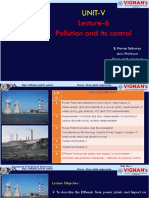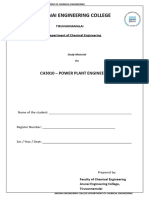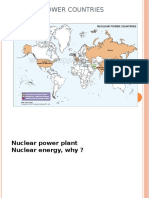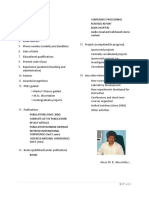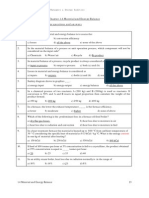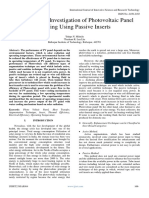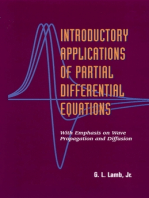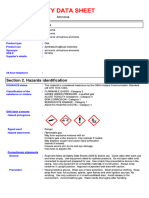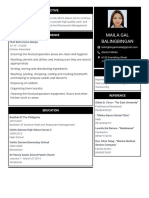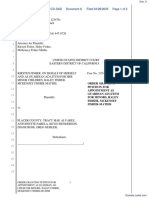Waste To Energy Conversion Technology Course Code: 4350502: Page 1 of 8
Waste To Energy Conversion Technology Course Code: 4350502: Page 1 of 8
Uploaded by
Cliches inCopyright:
Available Formats
Waste To Energy Conversion Technology Course Code: 4350502: Page 1 of 8
Waste To Energy Conversion Technology Course Code: 4350502: Page 1 of 8
Uploaded by
Cliches inOriginal Title
Copyright
Available Formats
Share this document
Did you find this document useful?
Is this content inappropriate?
Copyright:
Available Formats
Waste To Energy Conversion Technology Course Code: 4350502: Page 1 of 8
Waste To Energy Conversion Technology Course Code: 4350502: Page 1 of 8
Uploaded by
Cliches inCopyright:
Available Formats
Waste to energy conversion technology Course Code: 4350502
GUJARAT TECHNOLOGICAL UNIVERSITY (GTU)
Competency-focused Outcome-based Green Curriculum-2021(COGC-2021)
Semester-V
Course Title: Waste to Energy Conversion Technology
(Course Code: 4350502)
Diploma Programme in which this course is offered Semester in which offered
Chemical Engineering 5thSemester
1. RATIONALE
The objective of the course is to provide insights into waste management options by reducing
the waste destined for disposal and encouraging the use of waste as a resource for alternate
energy production. This course is designed to provide an understanding of the various aspects
of Waste to Energy. The various sources of waste generation are analyzed with a focus on its
potential for energy production. The need for characterization of wastes will be discussed
along with the existing norms for waste utilization for alternate energy source. Various
Technological options available for the production of energy form waste.
2. COMPETENCY
The course should be taught and curriculum should be implemented with the aim to develop
required skills so that students are able to acquire following competency:
To Supervise operation and to Optimize energy and Other Inventories
3. COURSE OUTCOMES(COs)
The theory, practical experiences and relevant soft skills associated with this course are to
be taught and implemented, so that the student demonstrates the following industry
oriented COs associated with the above mentioned competency:
a) Identify different wastes as a energy source
b) Apply concept of Thermo-chemical process for energy conversion
c) Apply concept of Biochemical process for energy conversion
d) Utilize algal biomass as source of energy production
4. TEACHING AND EXAMINATION SCHEME
Teaching Scheme Total Credits Examination Scheme
(In Hours) (L+T+P) Theory Marks Practical Marks Total
Marks
L T P C CA ESE CA ESE
3 - - 3 30* 70 - - 100
(*):Out of 30 marks under the theory CA,10 marks are for assessment of the micro-project to
facilitate the integration of COs, and the remaining 20 marks are the average of 2 tests to be
taken during the semester for assessing the attainment of the cognitive domain UOs
required for the attainment of the COs.
GTU - COGC-2021 Curriculum
Page 1 of 8
Waste to energy conversion technology Course Code: 4350502
Legends: L-Lecture; T – Tutorial/Teacher Guided Theory Practice; P - Practical; C – Credit,
CA -Continuous Assessment; ESE-End Semester Examination.
5. SUGGESTED PRACTICAL EXERCISES
The following practical outcomes (PrOs) are the sub-components of the COs. Some of the
PrOs marked ‘*’ (in approx. Hrs column) are compulsory, as they are crucial for that
particular CO at the ‘Precision Level’ of Dave’s Taxonomy related to ‘Psychomotor Domain’.
Sr. Practical/Exercise (Course Outcomes in Psychomotor Domain Unit Approx.
No. according to NBA Terminology) No. Hrs
Required
Not Applicable
Note
i. More Practical Exercises can be designed and offered by the respective course
teacher to develop the industry relevant skills/outcomes to match the COs. The
above table is only a suggestive list.
ii. The following are some sample ‘Process’ and ‘#Product’ related skills (more may be
added/deleted depending on the course) that occur in the above listed Practical
Exercises of this course required which are embedded in the COs and ultimately the
competency.
Sr. No. Sample Performance Indicators for the PrOs Weight age in %
1 Question answer or Writing steps exercise (Assignment) 30
2 Executing of exercise 30
3 Result 40
Total 100
6. MAJOR EQUIPMENT/INSTRUMENTS AND SOFTWARE REQUIRED
These major equipment/instruments and Software required to develop PrOs are given
below with broad specifications to facilitate procurement to them by the
administrators/management to the institutes. This will ensure the conduction of practice in
all institutions across the state in a proper ways other the desired skills are developing in
students.
Sr. No. Equipment Name with Broad Specifications PrO. No.
Not Applicable
7. AFFECTIVE DOMAIN OUTCOMES
The following sample Affective Domain Outcomes (ADOs) are embedded in many of the
above-mentioned COs and PrOs. More could be added to fulfill the development of this
competency.
a) Work as a leader/a team member.
b) Follow ethical practices
c) Observe safety measures
GTU - COGC-2021 Curriculum
Page 2 of 8
Waste to energy conversion technology Course Code: 4350502
d) Good house keeping
e) Time management
f) Practice environmentally friendly methods and processes.
The ADOs are best developed through laboratory/field-based exercises. Moreover, the level
of achievement of the ADOs according to Krathwohl’s ‘Affective Domain Taxonomy’ should
gradually increase as planned below:
i. ‘Valuing Level’ in 1st year
ii. ‘Organization Level’ in 2nd year.
iii. ‘Characterization Level’ in 3rd year.
8. UNDERPINNING THEORY
The major underpinning theory is given below based on the higher level UOs of Revised
Bloom’s taxonomy that are formulated for development of the COs and competency. If
required, more such higher-level UOs could be included by the course teacher to focus on the
attainment of COs and competency.
Major Learning
Unit Outcomes(Course Outcomes in Topics and Sub-topics
Cognitive Domain according to
NBA terminology)
1a. Classification of waste as 1.1 Definition of wastes and their classification
energy 1.2 Important quality parameters of different
types of wastes
Unit:1 1.3 Wastes suitable for energy production
Characterizati 1.4 Characterization of solid wastes and waste
1c. Characterization of
on of waste water
wastes
1d. Explain Technologies for 1.5 Energy from wastes, some scenario
Waste to Energy Conversion 1.6 Routes for energy production from wastes
1.7 Define Biochemical Conversion and Thermo-
chemical Conversion
1b. Explain Status of wastes 1.8 Status of waste to Energy conversion in India.
1d. Solve simple numerical 1.9 Numerical based on Characterization of
wastes
2a. Explain Mechanism of 2.1 Definition and scope of
Unit:2 combustion combustion/incineration
Thermo- 2.2 Environmental and health impacts of
incineration
chemical 2.3 Advantages and Disadvantages of combustion
Conversion 2.4 Air requirement for combustion
2b. Classification of combustors 2.5 Type of combustor
2.6 Energy production from wastes through
incineration
2c. Explain Basic chemistry of 2.7 Concept and Advantages of gasification
gasification
2d. Classification of Gasifier 2.8 Types of Gasifier
2.9 Energy production through gasification of
wastes
2e. Comparison Combustion 2.10 Comparison between incineration and
and gasification gasification
GTU - COGC-2021 Curriculum
Page 3 of 8
Waste to energy conversion technology Course Code: 4350502
2f. Classification of pyrolysis 2.11 Definition and mechanism of pyrolysis
2.12 Types of pyrolysis
2.13 Operating conditions and end product
distribution
2g Explain Properties of 2.14 Use of pyrolysis products
Pyrolysis products 2.15 Properties of bio oil and need of its
upgradation
2.16 Utilization of pyro char and gases
2h. Solve simple numerical 2.17 Numerical based on combustion,
gasification and Pyrolysis
3a. Outline Properties of 3.1 Properties of biogas (Calorific value and
Unit:3 biogas composition)
Biochemical 3.2 Factors affecting biogas yield
Conversion 3b. Explain and Classify 3.3 Feedstock’s and primary products of
Anaerobic digestion Anaerobic digestion
3.3 Mechanism of anaerobic digestion
3.5 Flow sheet for anaerobic digestion of wastes
3.6 Types of anaerobic digesters and their
operation
3c. Energy production from 3.7 Different energy sources from biomass /
wastes through fermentation wastes through fermentation
3.8 Production of ethanol from starchy crops
(corn), lingo cellulosic biomass (LCB) and
through gasification route
3.9 Butanol production from LCB
3d. Energy production from 3.10 Transesterification process and Organic
wastes through wastes for transesterification
transesterification 3.11 Production of bio oil from oil seeds and its
major composition
3.12 Up gradation of bio oil to bio diesel
3e. Solve simple numerical 3.13 Numerical based on biochemical
conversion process
Unit:4 4a. Explain algal cultivation 4.1 Why algal cultivation?
Cultivation of 4.2 Algal metabolism and synthesis of fat and
algal protein
Biomass 4b. Classify algae 4.3 Classification of microalgae phyla
4.4 Lipid content in algal cell
4c Show growth of microalgae 4.5 Reactor systems for cultivation/ growth of
microalgae
4b. Energy production from 4.6 Important energy production routes for algal
algal Biomass biomass
4.7 Conversion of algal oil to biodiesel
4.8 Types of conversion process, mechanisms
and comparison
4.9 Factors affecting biodiesel yield
GTU - COGC-2021 Curriculum
Page 4 of 8
Waste to energy conversion technology Course Code: 4350502
4.10 Upgradation of algal oil to bio diesel using
homogenous and heterogeneous catalysts
9. SUGGESTED SPECIFICATION TABLE FOR QUESTION PAPER DESIGN
Distribution of Theory Marks
Teaching
Unit Unit Title R U A Total
Hours
Level Level Level Marks
I Characterization of waste 6 2 4 2 8
II Thermo-chemical Conversion 14 5 10 10 25
III Biochemical Conversion 14 5 10 10 25
IV Cultivation of algal 8 6 6 0 12
Total 42 18 30 22 70
Legends: R=Remember, U=Understand, A=Apply and above (Revised Bloom’s taxonomy)
Note: This specification table provides general guidelines to assist students for their
learning and to teachers to teach and question paper designers/setters to formulate test
items/questions to assess the attainment of the UOs. The actual distribution of marks at
different taxonomy levels (of R, U and A) in the question paper may slightly vary from
above table.
10. SUGGESTED STUDENT ACTIVITIES
Other than the classroom and laboratory learning, following are the suggested student-related
co-curricular activities which can be undertaken to accelerate the attainment of the various
outcomes in this course: Students should perform following activities in group and prepare
reports of about 5 pages for each activity. They should also collect/record physical evidences for
their (student’s) portfolio which may be useful for their placement interviews:
Following is the list of proposed student activities like:
1. Assignments
2. Technical Quiz/MCQ Test
3. Presentation on some course topic
4. I-net based assignments
5. Undertake micro-Project in team/individually
11. SUGGESTED SPECIAL INSTRUCTIONAL STRATEGIES (if any)
These are sample strategies, which the teacher can use to accelerate the attainment of
the various outcomes in this course:
a) Massive open online courses (MOOCs) may be used to teach various topics/subtopics.
b) Guide student(s) in undertaking micro-projects/activities.
c) Different types of teaching methods i.e. video demonstration, activity based learning,
case study, m-learning need to be employed by teachers to develop the outcomes.
d) Some of the topics/sub-topics which is relatively simpler or descriptive is to be given to
the students for self-learning but to be assessed using different assessment methods.
e) Teachers need to ensure to create opportunities and provisions for co-curricular
activities.
GTU - COGC-2021 Curriculum
Page 5 of 8
Waste to energy conversion technology Course Code: 4350502
f) Guide students to address issues on environment and sustainability with reference to
using the knowledge of this course
g) OERs, Vlab, and Olabs may be used to teach for the teaching of different concepts.
12. SUGGESTED MICRO-PROJECTS
Only one micro-project is planned to be undertaken by a student that needs to be assigned
to him/her at the beginning of the semester. In the first four semesters, the micro-project is
group-based (group of 3 to 5). However, in the fifth and sixth semesters, the number of
students in the group should not exceed three.
The micro-project could be industry application-based, internet-based, workshop-based,
laboratory-based, or field-based. Each micro-project should encompass two or more COs
which are the integration of PrOs, UOs, and ADOs. Each student will have to maintain dated
work diary consist in go find individual contributions in the project work and give a seminar
presentation of it before submission. The duration of the micro project should be about 14-
16 (fourteen to sixteen) student engagement hours during the course. The students ought
to submit micro-project by the end of the semester (so that they develop industry-oriented
COs).
A suggestive list of micro-projects is given here. This should relate highly to the competency
of the course and the COs. Similar micro-projects could be added by the concerned course
teacher.
1 Prepare chart/model of Classification of waste along with their Mechanism and applications
2 Prepare chart of Status of waste to Energy conversion in India
3 Prepare chart/model types of Combustor
4 Draw suitable chart for various Combustor equipment
5 Prepare 15-20 slides power point presentation showing Classification of waste along with
their examples
6 Prepare 15-20 slides power point presentation Characterization of wastes
7 Prepare 15-20 slides power point presentation on Waste to energy technology
8 Prepare a demonstrative model of any Gasifier reactor
9 Prepare a demonstrative model of any waste to energy conversion technology equipment
10 Prepare Working model of any waste to energy conversion technology equipment
11 Prepare 15-20 slides power point presentation on energy crisis in India and its solution
12 Prepare a model on pyrolysis system that can convert plastic into gas or oil.
13 Prepare chart/model of Incineration.
14 Prepare 15-20 slides power point presentation on comparison of seven different countries
best practices for waste energy recovery with India.
13. SUGGESTED LEARNING RESOURCES
Sr.
Title of Books Author Publication with place, year and ISBN
No.
Waste-to-Energy:
Marc J Rogoff Dr and William Andrew; 2nd edition (15 June
1 Technologies and Project
Francois Screve 2011)
Implementation
GTU - COGC-2021 Curriculum
Page 6 of 8
Waste to energy conversion technology Course Code: 4350502
Khandelwal K. C. and Vol. I & II Tata
2 Biogas Technology
Mahdi S. S McGraw Hill Publishing Co. Ltd., 1983
Vesilind P.A. and
3 Solid Waste Engineering 2nd Ed. Cengage India (2016)
Worrell W. A
Thermo-chemical Processing
4 of Biomass: Conversion into Robert C. Brown, John Wiley and Sons, USA (2019)
Fuels, Chemicals and Power
Municipal Solid Waste to
5 Young G.C John Wiley and Sons
Energy Conversion processes
14. SUGGESTED LEARNING WEBSITES
a) https://onlinecourses.nptel.ac.in/noc23_ch05/
b) https://www.teriin.org/projects/green/pdf/National-Waste.pdf
c) https://www.eai.in/ref/ae/wte/typ/clas/india_industrial_wastes.html
d) Ministry of New & Renewable Energy - Government of India (mnre.gov.in)
e) http://www.ottusa.com/synthetic_fuel/synthetic_fuel
f) OSHA Technical Manual (OTM) | Occupational Safety and Health Administration
g) https://youtu.be/jYry2xe-HqY
h) https://youtu.be/MuYdfxanAk8
i) https://youtu.be/uXU2Pcxokb4
15. PO-COMPETENCY-CO MAPPING
Waste to energy conversion technology (4350502)
Semester V
POs
PO1 PO2 PO3 PO4 PO5 PO6 PO7
Basic & Problem Design/dev Engineerin Engineering Project Life-
Competency Discipline Analysis elopment g Tools, practices for Manageme long
& Course -specific of Experiment society, nt learning
Outcomes knowledg solutions ation sustainability
e &Testing &
environment
Competency To Supervise operation and to Optimize energy and Other Inventories
CO1: Identify
different wastes as 2.00 3.00 1.00 - 1.00 1.00 3.00
a energy source
CO2: Apply concept
of Thermo-
chemical 1.00 3.00 3.00 1.00 2.00 1.00 2.00
Conversion for
biogas production
CO3: Apply concept
of Bio-chemical
1.00 3.00 3.00 1.00 2.00 1.00 2.00
Conversion for
biogas production
CO4: Utilize algal
biomass as source
1.00 2.00 2.00 - 2.00 1.00 2.00
of energy
production
GTU - COGC-2021 Curriculum
Page 7 of 8
Waste to energy conversion technology Course Code: 4350502
16. COURSE CURRICULUM DEVELOPMENT COMMITTEE
GTU Resource Persons
Contact
Sr. Institute Email ID
Name and Designation No.
No.
Mr. SHAH PARTH SATISHBHAI GOVERNMENT parthgcet@gmail.com
1 (Lecturer in chemical POLYTECHNIC,
Engineering) GANDHINAGAR ----------
Mr. SOSA VIDURKUMAR GOVERNMENT vidur.sosa@gmail.com
PUNJABHAI POLYTECHNIC,
2 (Lecturer in chemical RAJKOT ----------
Engineering)
GTU - COGC-2021 Curriculum
Page 8 of 8
You might also like
- (Barash) Clinical Anesthesia (6th Ed.)Document3,968 pages(Barash) Clinical Anesthesia (6th Ed.)menocide_ss67% (3)
- Effluents From Power Plants and Impact On EnvironmentDocument23 pagesEffluents From Power Plants and Impact On Environmentcherry tejaNo ratings yet
- CO2 Recovery Plant, NFCL, Andhra Pradesh (India)Document9 pagesCO2 Recovery Plant, NFCL, Andhra Pradesh (India)Sanjiv ChNo ratings yet
- Plant UtilitiesDocument8 pagesPlant Utilitiestdhyey63No ratings yet
- Chem-E-Car Sefter Conception: Muhammad Miftahur Rahman Habib Al Aziz Fitri Handayani ArcodheaDocument16 pagesChem-E-Car Sefter Conception: Muhammad Miftahur Rahman Habib Al Aziz Fitri Handayani ArcodhearahmanNo ratings yet
- Course Title:: Petroleum Refining & Petrochemical Technology Course Code: 3350503Document7 pagesCourse Title:: Petroleum Refining & Petrochemical Technology Course Code: 3350503Viraj Patel100% (1)
- PDFDocument74 pagesPDFHARISHKOTHARU48No ratings yet
- Chapter Two: General Design ConsiderationsDocument27 pagesChapter Two: General Design ConsiderationsTeddy Ekubay GNo ratings yet
- MRP Shemes Form New1Document19 pagesMRP Shemes Form New1khyatichavda100% (1)
- Fluid Mechanics Lect Notes With Sample QuesDocument96 pagesFluid Mechanics Lect Notes With Sample QuesMahin Samuel John 74No ratings yet
- Lab Manuals 2CH403 IPC Jan 2020 PDFDocument47 pagesLab Manuals 2CH403 IPC Jan 2020 PDFSamriddha Das GuptaNo ratings yet
- Mahalakshmi Engineering College, Thudaiyur, Trichy. Unit - Iii, Alloys and Phase Rule 2 Marks Questions and AnswersDocument12 pagesMahalakshmi Engineering College, Thudaiyur, Trichy. Unit - Iii, Alloys and Phase Rule 2 Marks Questions and AnswersEmmanuel ThomasNo ratings yet
- Process Control and InstrumentationDocument14 pagesProcess Control and InstrumentationSiddhant SinhaNo ratings yet
- ME482 Energy Conservation and ManagementDocument2 pagesME482 Energy Conservation and Managementnandan144No ratings yet
- Critical PointDocument15 pagesCritical PointDominic LibradillaNo ratings yet
- Toro - The Environmental Impacts of Renewable EnergyDocument9 pagesToro - The Environmental Impacts of Renewable Energyanmn123No ratings yet
- Nptel PDFDocument5 pagesNptel PDFGOWTHAM GUPTHANo ratings yet
- TareaDocument1 pageTarealalo riosNo ratings yet
- CH3010 - Power Plant Engineering Notes .Document75 pagesCH3010 - Power Plant Engineering Notes .VijayNo ratings yet
- Mod1-EE474 Energy Management and Auditing-KTUStudents - inDocument51 pagesMod1-EE474 Energy Management and Auditing-KTUStudents - inDeepu V SNo ratings yet
- IPC QuestionsDocument12 pagesIPC QuestionsBhakti MahbubaniNo ratings yet
- 779617436Document10 pages779617436Joaquín Estrada GarNo ratings yet
- Energy Efficiency in Thermal UtilitiesDocument183 pagesEnergy Efficiency in Thermal UtilitiesHimanshuNo ratings yet
- Microbial Fuel Cell MaterialDocument364 pagesMicrobial Fuel Cell MaterialpiaNo ratings yet
- W13 NOx ControlDocument43 pagesW13 NOx Controlmr styloNo ratings yet
- 39 Algal Oil Production 1Document21 pages39 Algal Oil Production 1Sai Srivathsava UdathuNo ratings yet
- Power Plant Technology by El WakilDocument46 pagesPower Plant Technology by El WakilMuhammad Yasar Javaid100% (1)
- Nuclear Power PlantDocument61 pagesNuclear Power PlantNilesh SinghNo ratings yet
- Study Questions About Wind EnergyDocument5 pagesStudy Questions About Wind EnergyIsmail Serkan KabatasNo ratings yet
- Fluid Mechanics: The Gate CoachDocument18 pagesFluid Mechanics: The Gate CoachSandeep CharanNo ratings yet
- CV K Muralidhar February 2018 PDFDocument43 pagesCV K Muralidhar February 2018 PDFBalakrishna ChowdaryNo ratings yet
- Material and Energy Balance Q&ADocument10 pagesMaterial and Energy Balance Q&AEmyboy AgboNo ratings yet
- Environmental Technology & InnovationDocument21 pagesEnvironmental Technology & InnovationaissaNo ratings yet
- HPCLDocument6 pagesHPCLraghu sandilyaNo ratings yet
- Energy Utilization and Audit: Chemical Engineering Dept. Wolkite UniversityDocument14 pagesEnergy Utilization and Audit: Chemical Engineering Dept. Wolkite UniversityGetasew TesfaNo ratings yet
- Geothermal Steam-Water Separators: Design Overview: Geothermics January 2015Document20 pagesGeothermal Steam-Water Separators: Design Overview: Geothermics January 2015Karla HerediaNo ratings yet
- Recycle and Bypass ProcessesDocument5 pagesRecycle and Bypass Processesjohn_424940% (1)
- Literature ReviewDocument5 pagesLiterature ReviewSaurabh KumarNo ratings yet
- Seminar Solar DistillationDocument14 pagesSeminar Solar DistillationBharath BharmaNo ratings yet
- Report On Desiging CompanyDocument53 pagesReport On Desiging CompanyArpit ThumarNo ratings yet
- Chy 101 Jain and JainDocument5 pagesChy 101 Jain and JainNikhil Kumar100% (1)
- Experimental Investigation of Photovoltaic Panel Cooling Using Passive InsertsDocument7 pagesExperimental Investigation of Photovoltaic Panel Cooling Using Passive InsertsInternational Journal of Innovative Science and Research Technology100% (1)
- A Review: Biogas Production From Bakery WasteDocument5 pagesA Review: Biogas Production From Bakery WasteEditor IJTSRDNo ratings yet
- Moodle Basic ThermodynamicsDocument14 pagesMoodle Basic ThermodynamicsArpan BiswasNo ratings yet
- Three Fundamental Laws of Transport PhenomenaDocument3 pagesThree Fundamental Laws of Transport PhenomenaGenetNo ratings yet
- Chapter 1-Separation Process OverviewDocument20 pagesChapter 1-Separation Process OverviewmynurulNo ratings yet
- Extra Momentum Transfer QuestionsDocument5 pagesExtra Momentum Transfer QuestionsaNo ratings yet
- Modern Theory of CorrosionDocument98 pagesModern Theory of CorrosionMujahid HaddadNo ratings yet
- Non-Conventional Energy Resources: By: Deepak PandeyDocument9 pagesNon-Conventional Energy Resources: By: Deepak PandeyVijay KumarNo ratings yet
- Material Selection Consideration For ReactorsDocument6 pagesMaterial Selection Consideration For ReactorsMiera Yushira YusoffNo ratings yet
- Machines Lab ManualDocument124 pagesMachines Lab ManualpurushothNo ratings yet
- Fermentation Technology Chapter VviDocument42 pagesFermentation Technology Chapter VviChristine GoodwinNo ratings yet
- Cognizant Genc Roles and Packages: ContentDocument20 pagesCognizant Genc Roles and Packages: ContentAARATHI LNo ratings yet
- Me2401 Mechatronics - 2 Marks With AnswerDocument29 pagesMe2401 Mechatronics - 2 Marks With AnswerAravind Selva50% (2)
- Topic 1 - Introduction Mechanical OperationsDocument82 pagesTopic 1 - Introduction Mechanical OperationsAmeen HussainNo ratings yet
- HMTDocument234 pagesHMTkanivelNo ratings yet
- Topic 2 - 2.2 Mechanical OperationsDocument43 pagesTopic 2 - 2.2 Mechanical OperationsAmeen HussainNo ratings yet
- BTP Report Rahul FinalDocument170 pagesBTP Report Rahul FinalGopal VermaNo ratings yet
- Introductory Applications of Partial Differential Equations: With Emphasis on Wave Propagation and DiffusionFrom EverandIntroductory Applications of Partial Differential Equations: With Emphasis on Wave Propagation and DiffusionNo ratings yet
- Us 2839580Document4 pagesUs 2839580Cliches inNo ratings yet
- MT IiDocument19 pagesMT IiCliches inNo ratings yet
- ( - 5)Document4 pages( - 5)Cliches inNo ratings yet
- Perform Separation Operations For Purification of Raw Materials and ProductsDocument11 pagesPerform Separation Operations For Purification of Raw Materials and ProductsCliches inNo ratings yet
- Handbook On Solid WasteDocument73 pagesHandbook On Solid WasteCliches inNo ratings yet
- AMMONIADocument12 pagesAMMONIACliches inNo ratings yet
- Opd - Scan Ii PDFDocument6 pagesOpd - Scan Ii PDFDfhos Oftalmo ServiceNo ratings yet
- Etheno-Medicinal Plant of Saputara Hill, Dang District, GujaratDocument7 pagesEtheno-Medicinal Plant of Saputara Hill, Dang District, GujaratSAKARIYA PRARTHNANo ratings yet
- Executive Position Profile - President of RiseDocument7 pagesExecutive Position Profile - President of RiseLars Leafblad100% (1)
- Practice Test 2: ListeningDocument6 pagesPractice Test 2: ListeningrhusheinNo ratings yet
- Name: Sajeel Khan Roll#:M.phil-SSP-03-F19 Class: M.phil SSP (Morning) Subject: Optical Properties of Solid Submitted TODocument8 pagesName: Sajeel Khan Roll#:M.phil-SSP-03-F19 Class: M.phil SSP (Morning) Subject: Optical Properties of Solid Submitted TOAnonymous f7wV1lQKRNo ratings yet
- MS For Sewer Line Road CrossingDocument10 pagesMS For Sewer Line Road CrossingSarfraz Randhawa100% (1)
- Home Economics-Bread and Pastry ProductionDocument6 pagesHome Economics-Bread and Pastry ProductionJuan L. CruzNo ratings yet
- Electronic 5S: An Introduction To Digital Workplace OrganizationDocument32 pagesElectronic 5S: An Introduction To Digital Workplace Organizationjemal yahyaaNo ratings yet
- Ats2m1 1 16a 230VDocument2 pagesAts2m1 1 16a 230Vmariam fekiNo ratings yet
- Maila Apdate ResumeDocument1 pageMaila Apdate Resumemairon windsuorNo ratings yet
- Anesthesia NutshellDocument388 pagesAnesthesia NutshellMuhammad UmerNo ratings yet
- Term 2 - Grade 8 Science Chapter 6 Conservation of Plants and AnimalsDocument3 pagesTerm 2 - Grade 8 Science Chapter 6 Conservation of Plants and Animalsris.aryajoshiNo ratings yet
- SERVICE MANUAL For Aqv09ewanDocument83 pagesSERVICE MANUAL For Aqv09ewangcharalNo ratings yet
- Sanchay Par Advantage Deffered IncomeDocument3 pagesSanchay Par Advantage Deffered IncomeTamil Vanan NNo ratings yet
- Fisher Et Al v. Placer County, Et Al. - Document No. 6Document2 pagesFisher Et Al v. Placer County, Et Al. - Document No. 6Justia.comNo ratings yet
- Data Sheets FOR Pressure Safety ValvesDocument8 pagesData Sheets FOR Pressure Safety Valvessunildubey02No ratings yet
- 06 Asme Teoria de MaterialesDocument340 pages06 Asme Teoria de MaterialesalexNo ratings yet
- Human Rights, Environmental Rights.Document42 pagesHuman Rights, Environmental Rights.Emmanuel O.100% (2)
- Chapter - 5 Fundamental Unit of LifeDocument12 pagesChapter - 5 Fundamental Unit of LifehelloNo ratings yet
- General Approach To Cyanotic Spell in Pediatric With Congenital Heart DiseaseDocument29 pagesGeneral Approach To Cyanotic Spell in Pediatric With Congenital Heart Diseaseelok_88No ratings yet
- Mark Scheme: Assessment Unit A2 1Document10 pagesMark Scheme: Assessment Unit A2 1chowdhuryNo ratings yet
- Design and Costing of Drainage Network For Unilorin Lake ResortDocument15 pagesDesign and Costing of Drainage Network For Unilorin Lake ResortDr Olayinka Okeola100% (1)
- What Are The Engineering and Physical Properties of StonesDocument3 pagesWhat Are The Engineering and Physical Properties of StonesDeven PatleNo ratings yet
- Member Booklets Pmi Ia Medical Global Plan Lta 1120 PDFDocument12 pagesMember Booklets Pmi Ia Medical Global Plan Lta 1120 PDFbkourfatima8No ratings yet
- Working Instructions DOC26 ACN634 R9i PP300 RevcDocument38 pagesWorking Instructions DOC26 ACN634 R9i PP300 RevcJezer LugoNo ratings yet
- Practical No: 7 STATEMENT: Two Different Types of Drugs D: X X S N NDocument2 pagesPractical No: 7 STATEMENT: Two Different Types of Drugs D: X X S N NUnisa SakhaNo ratings yet
- Baby Girl AkitaDocument25 pagesBaby Girl AkitasteffiNo ratings yet
- 19.design 102.00Document5 pages19.design 102.00Fredin FrancisNo ratings yet

